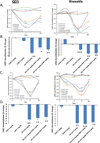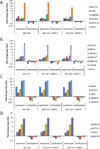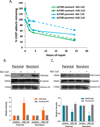The novel, small-molecule DNA methylation inhibitor SGI-110 as an ovarian cancer chemosensitizer
- PMID: 25316809
- PMCID: PMC4268357
- DOI: 10.1158/1078-0432.CCR-14-1553
The novel, small-molecule DNA methylation inhibitor SGI-110 as an ovarian cancer chemosensitizer
Abstract
Purpose: To investigate SGI-110 as a "chemosensitizer" in ovarian cancer and to assess its effects on tumor suppressor genes (TSG) and chemoresponsiveness-associated genes silenced by DNA methylation in ovarian cancer.
Experimental design: Several ovarian cancer cell lines were used for in vitro and in vivo platinum resensitization studies. Changes in DNA methylation and expression levels of TSG and other cancer-related genes in response to SGI-110 were measured by pyrosequencing and RT-PCR.
Results: We demonstrate in vitro that SGI-110 resensitized a range of platinum-resistant ovarian cancer cells to cisplatin (CDDP) and induced significant demethylation and reexpression of TSG, differentiation-associated genes, and putative drivers of ovarian cancer cisplatin resistance. In vivo, SGI-110 alone or in combination with CDDP was well tolerated and induced antitumor effects in ovarian cancer xenografts. Pyrosequencing analyses confirmed that SGI-110 caused both global (LINE1) and gene-specific hypomethylation in vivo, including TSGs (RASSF1A), proposed drivers of ovarian cancer cisplatin resistance (MLH1 and ZIC1), differentiation-associated genes (HOXA10 and HOXA11), and transcription factors (STAT5B). Furthermore, DNA damage induced by CDDP in ovarian cancer cells was increased by SGI-110, as measured by inductively coupled plasma-mass spectrometry analysis of DNA adduct formation and repair of cisplatin-induced DNA damage.
Conclusions: These results strongly support further investigation of hypomethylating strategies in platinum-resistant ovarian cancer. Specifically, SGI-110 in combination with conventional and/or targeted therapeutics warrants further development in this setting.
©2014 American Association for Cancer Research.
Figures






Similar articles
-
Candidate DNA methylation drivers of acquired cisplatin resistance in ovarian cancer identified by methylome and expression profiling.Oncogene. 2012 Oct 18;31(42):4567-76. doi: 10.1038/onc.2011.611. Epub 2012 Jan 16. Oncogene. 2012. PMID: 22249249
-
Combined inhibition of DNA methylation and histone acetylation enhances gene re-expression and drug sensitivity in vivo.Br J Cancer. 2009 Mar 10;100(5):758-63. doi: 10.1038/sj.bjc.6604932. Br J Cancer. 2009. PMID: 19259094 Free PMC article.
-
Immunomodulatory action of the DNA methyltransferase inhibitor SGI-110 in epithelial ovarian cancer cells and xenografts.Epigenetics. 2015;10(3):237-46. doi: 10.1080/15592294.2015.1017198. Epigenetics. 2015. PMID: 25793777 Free PMC article.
-
Novel factors of cisplatin resistance in epithelial ovarian tumours.Adv Med Sci. 2025 Mar;70(1):94-102. doi: 10.1016/j.advms.2025.01.005. Epub 2025 Jan 27. Adv Med Sci. 2025. PMID: 39880191 Review.
-
[Research Progress of DNA Methylation in Cisplatin Resistance in Lung Cancer].Zhongguo Fei Ai Za Zhi. 2023 Jan 20;26(1):52-58. doi: 10.3779/j.issn.1009-3419.2023.101.03. Zhongguo Fei Ai Za Zhi. 2023. PMID: 36792081 Free PMC article. Review. Chinese.
Cited by
-
Functional characterization of a panel of high-grade serous ovarian cancer cell lines as representative experimental models of the disease.Oncotarget. 2016 May 31;7(22):32810-20. doi: 10.18632/oncotarget.9053. Oncotarget. 2016. PMID: 27147568 Free PMC article.
-
DNA Methylome Analyses Implicate Fallopian Tube Epithelia as the Origin for High-Grade Serous Ovarian Cancer.Mol Cancer Res. 2016 Sep;14(9):787-94. doi: 10.1158/1541-7786.MCR-16-0097. Epub 2016 Jun 3. Mol Cancer Res. 2016. PMID: 27259716 Free PMC article.
-
Combining epigenetic and immune therapy to overcome cancer resistance.Semin Cancer Biol. 2020 Oct;65:99-113. doi: 10.1016/j.semcancer.2019.12.019. Epub 2019 Dec 23. Semin Cancer Biol. 2020. PMID: 31877341 Free PMC article. Review.
-
FOXD3 may be a new cellular target biomarker as a hypermethylation gene in human ovarian cancer.Cancer Cell Int. 2019 Feb 28;19:44. doi: 10.1186/s12935-019-0755-8. eCollection 2019. Cancer Cell Int. 2019. PMID: 30858761 Free PMC article.
-
Eleven genes associated with progression and prognosis of endometrial cancer (EC) identified by comprehensive bioinformatics analysis.Cancer Cell Int. 2019 May 20;19:136. doi: 10.1186/s12935-019-0859-1. eCollection 2019. Cancer Cell Int. 2019. PMID: 31139013 Free PMC article.
References
-
- Siegel R, Naishadham D, Jemal A. Cancer statistics, 2013. CA: a cancer journal for clinicians. 2013;63:11–30. - PubMed
-
- Ozols RF. Recurrent ovarian cancer: evidence-based treatment. Journal of clinical oncology : official journal of the American Society of Clinical Oncology. 2002;20:1161–1163. - PubMed
Publication types
MeSH terms
Substances
Grants and funding
LinkOut - more resources
Full Text Sources
Other Literature Sources
Medical
Miscellaneous

